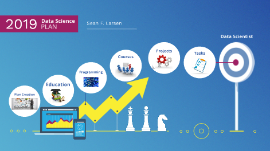Data Science Presentation
Transcript: Bar Charts Line Graphs Bar charts are effective for comparing discrete categories, allowing viewers to easily see variations in size and frequency across different groups. They are particularly useful for representing counts or frequencies of categorical data. Line graphs are ideal for showing trends over time, making it easy to visualize changes in data points across intervals. They are commonly used for time-series data to depict how a variable evolves. Applications of Data Science Healthcare Innovation Marketing Strategy Enhancement Sports Performance Analysis Financial Services Optimization In marketing, data science enables targeted campaigns and customer segmentation, enhancing engagement and conversion rates by analyzing consumer behavior and preferences. In healthcare, data science improves patient outcomes through predictive analytics and personalized medicine, revolutionizing treatment plans and patient care. Financial institutions leverage data science for risk assessment, fraud detection, and automated trading strategies, enabling smarter financial decisions and increasing profitability. Sports teams utilize data science for performance analysis, player scouting, and game strategy development, leading to improved team performance and fan engagement. Data Privacy Concerns Data privacy concerns arise from the need to protect sensitive information, as mishandling data can lead to serious legal and ethical implications for organizations. Need for High-Quality Data Challenges in Data Science High-quality data is crucial for accurate analysis and decision-making. Poor data quality can lead to misleading insights and ineffective strategies. Complexity of Algorithms The complexity of algorithms can pose challenges in implementation and interpretation, requiring skilled professionals who can navigate intricate data models. Understanding Machine Learning Machine learning, a key aspect of artificial intelligence, allows systems to automatically improve their performance through experience. By analyzing large datasets, these systems can uncover hidden patterns and make informed predictions without explicit programming for every task. Summarizes Data Characteristics Exploratory Data Analysis (EDA) not only summarizes the data but also helps in forming hypotheses for further analysis. It is a critical step in the data analysis process, allowing analysts to gain insights before applying more formal modeling techniques. Utilizes Visual Methods Importance of Exploratory Data Analysis Visualizations such as histograms, box plots, and scatter plots are essential tools in EDA, as they provide a graphical representation of data distributions and relationships, making it easier to spot outliers and trends. Identifies Data Quality Issues EDA is beneficial for identifying data quality issues, such as missing values or incorrect data entries. By understanding the data's structure and properties, analysts can prepare the dataset for more complex analyses. Future Trends in Data Science Key developments shaping the future of data science and its applications. 2025 2023 Real-time data analytics is transforming decision-making processes, providing immediate insights to businesses. Automated machine learning tools are becoming more accessible, enabling non-experts to leverage AI. 2024 Ethical AI practices are being adopted across the industry to ensure responsible data usage and algorithm transparency. Data Science: A Crucial Evolving Field Data science plays a critical role in helping organizations make informed decisions through data-driven insights. Its continuous evolution necessitates that organizations stay updated and adapt their strategies to fully harness its capabilities for better outcomes and innovation. Machine Learning Improves Predictions AI Enhances Decision-Making Transforming Industries Artificial Intelligence (AI) utilizes algorithms and statistical models to analyze and interpret complex data, enabling machines to perform tasks that typically require human intelligence. Machine learning, a subset of AI, allows systems to learn from data, continually improving their accuracy in making predictions or decisions without being explicitly programmed. AI technologies are transforming industries by automating tasks, personalizing user experiences, and generating insights from vast amounts of data, making them essential in today’s digital economy. AI Presentation Artificial Intelligence in Data Science An Overview of Data Science Concepts, Techniques, and Applications Understanding Data Science Data science merges various disciplines, including statistics, computer science, and domain expertise to analyze data effectively. It employs methodologies to derive actionable insights from both structured and unstructured datasets, making it essential in today’s data-driven world. Informed Decision-Making Data science plays a vital role in informed decision-making, allowing organizations to analyze data trends and make

















